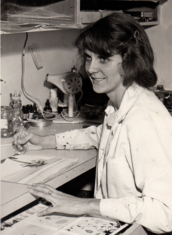Sally Cruikshank
Filmmaker
Sally Cruikshank was born in Chatham, New Jersey, in 1949. She developed a passion for animation at an early age, watching classic 1930s cartoons on the television. In her last year at university at Smith College (Massachusetts), where she studied Art, she made her first 16mm animated short (Ducky, 1971), completely self-taught, when she was 22. The three-minute film, made using watercolours and animation on paper, was filmed with a Bolex attached to a photo enlarger. Spurred on the by the positive reception of Ducky, Cruikshank enrolled at the San Francisco Art Institute, where she studied filmmaking with Larry Jordan. On the back of her work in the course of those years, she was hired by one of the first big animation film companies, Snazelle Films, where she started to work on adverts and films, developing her recognisable style based on surrealistic, psychedelic and countercultural elements.
Quasi at the Quackadero, made in 1975, is her best-known work. The film brings together several of her stylistic traits, starting with its lead, Quasi, a talking duck who is direct heir to the anthropomorphic characters who appeared in her first short. The film is the product of two years’ work with cels and is the only animation by a woman to be included in the publication The 50 Greatest Cartoons, selected by a team of 1000 professionals in the field.
Cruikshank’s work stands out for the great creativity that emanates from her films: vibrant, vertiginous worlds where the laws of physics are malleable, atmospheres are exuberant, and all the characters—whether or not they are living beings—can see, speak and take part in the action. Her work is an expression in itself of the freedom and pleasure that Cruikshank felt in doing it. A versatile artist, she was also a pioneer in digital animation, including the creation of GIFs, bots, programming codes and the publication and dissemination of short animations on her own blog in the early years of the internet. In 2010 she transferred all her work—which, as well as acclaimed works, includes commercial film credits and sequences, and clips for Sesame Street—into 35mm film format for preservation.
Update: 8 April 2024
